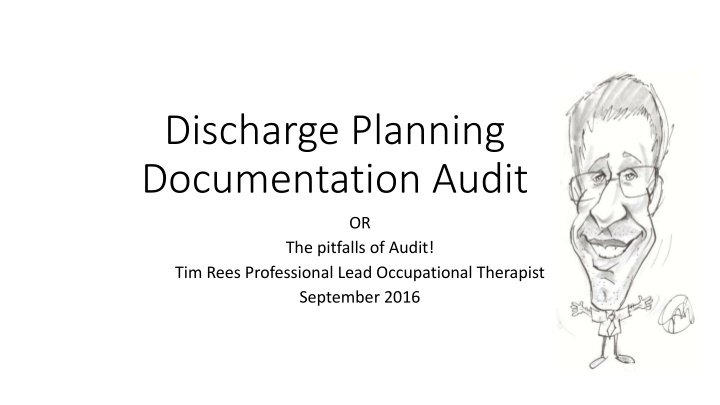
Discharge Planning Documentation Audit: Strategies for Enhanced Patient Care
Explore the intricacies of discharge planning documentation audits and discover tips to improve patient outcomes. Follow along as Tim Rees, a seasoned Occupational Therapist, shares insights into developing audit tools, data collection, and key findings. Uncover the challenges and solutions in optimizing patient discharge processes for better healthcare delivery.
Download Presentation

Please find below an Image/Link to download the presentation.
The content on the website is provided AS IS for your information and personal use only. It may not be sold, licensed, or shared on other websites without obtaining consent from the author. If you encounter any issues during the download, it is possible that the publisher has removed the file from their server.
You are allowed to download the files provided on this website for personal or commercial use, subject to the condition that they are used lawfully. All files are the property of their respective owners.
The content on the website is provided AS IS for your information and personal use only. It may not be sold, licensed, or shared on other websites without obtaining consent from the author.
E N D
Presentation Transcript
Discharge Planning Documentation Audit OR The pitfalls of Audit! Tim Rees Professional Lead Occupational Therapist September 2016
Content Outline of the audit proposal Developing the audit tool Data collection Findings What next!
Audit Proposal Ready to go: Planning the discharge and the transfer of patient from Hospital and Intermediate care (2010) Department of Health. Speed of discharges from the acute hospital. Exacerbated by ward transfers leading to changes of staff. Hypothesis: Can we improve the documentation of the patients/family discharge goals and the discharge planning which involves the therapy team throughout the stay in hospital? Observation: The plan was often present but difficult to follow, if patient was moved to another ward.
Health Warning We are not the only people involved in discharge!
Developing the Audit Tool!!! Thank you to all the team who were involved in developing the questionnaire. (Twice!) We wanted to look at the process and see how transparent it was in the notes!! Consent/Patient and family perception /Equipment/Support! Looked simple on paper!
Data Collection First trial! Second trial: Problem: Notes to be reviewed after discharge by colleague who did not know patient. (I would ask staff to do at one of our most busy periods!) Led to variation in data. Did the data help with the hypothesis?
Findings (Demographics) Five patients first trial Ten patients second trial
Dilemma!! Both trials showed that we do follow and document process. BUT Finding the data in the notes was problematic and it is not standardised.
Hind sight Too many questions. Should have asked the obvious question: How accessible is the information for staff to find? (not just therapy staff!) Does it matter, the process is there (MDT do not read it anyway!) Wanted to involve staff, but the data not uniform.
What next? Discharge Goal: The patient/carers preferred outcome when leaving hospital. Discharge Plan: The steps leading to discharge which should be regularly referred to in treatment notes. (Should this be highlighted in some way?) Document equipment and support /referrals made. Paperwork gets lost in the notes so please document. Agreed standards.
